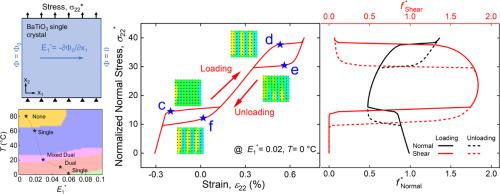双超弹性:异常和可调变形的途径
IF 9.4
1区 工程技术
Q1 ENGINEERING, MECHANICAL
International Journal of Mechanical Sciences
Pub Date : 2025-09-09
DOI:10.1016/j.ijmecsci.2025.110817
引用次数: 0
摘要
无机铁电材料往往具有脆性。超弹性是一种显著的应力-应变行为,其特征是大量非线性“塑性”应变的恢复。这为克服无机铁电材料的变形限制提供了一种有前途的方法,使其能够应用于传感器,致动器和阻尼器。然而,超弹性的精确调制仍然是难以捉摸的,超弹性变形的进一步改进仍然是必要的。本文首次揭示了剪切弹性能量密度作为控制这些材料超弹性的基本机制的关键作用。利用这一见解,我们预测并证明了具有优异变形能力的双超弹性行为,这在单晶铁电体中是无法实现的。这种双重超弹性行为源于剪切弹性能量密度的显著和持续存在。多场调制下的超弹性行为图揭示了单晶铁电体中存在五种不同的超弹性态。最重要的是,与传统的非超弹性应力-应变曲线相比,双超弹性的总可恢复应变提高了30.5%,比单超弹性的可恢复应变提高了17%,这代表了可实现变形的突破。多层超弹性行为和相应的剪切弹性能量密度中心机制为解决无机铁电器件在复杂多场环境下的脆性缺陷提供了专门的解决方案。本文章由计算机程序翻译,如有差异,请以英文原文为准。

Dual superelasticity: A pathway to exceptional and modulable deformation
Inorganic ferroelectric materials often suffer from brittleness. Superelasticity is a notable stress-strain behavior characterized by the recovery of large amount of nonlinear “plastic” strains. This offers a promising approach to overcome the deformation limitation of inorganic ferroelectric materials, enabling their applications in sensors, actuators and dampers. However, precise modulation of superelasticity remains elusive, and further improvement of superelastic deformation is still essential. This paper reveals, for the first time, the critical role of shear elastic energy density as the fundamental mechanism governing superelasticity in these materials. Leveraging this insight, we predict and demonstrate a dual superelasticity behavior with excellent deformation ability, which is not realized in single-crystal ferroelectrics. This dual superelasticity behavior stems from the significant and sustained presence of shear elastic energy density. The diagram for superelastic behavior under the modulation of multi-fields reveals the existence of five distinct superelasticity states in single-crystal ferroelectrics. Crucially, the dual superelasticity delivers a remarkable 30.5 % improvement in total recoverable strain compared to a traditional none superelastic stress-strain curve, and a 17 % gain over a single superelasticity, representing a breakthrough in achievable deformation. The multi-levels superelastic behavior and the corresponding shear elastic energy density centered mechanism offer a solution specifically designed to address the brittleness drawback of inorganic ferroelectric devices especially under complex multi-fields environments.
求助全文
通过发布文献求助,成功后即可免费获取论文全文。
去求助
来源期刊

International Journal of Mechanical Sciences
工程技术-工程:机械
CiteScore
12.80
自引率
17.80%
发文量
769
审稿时长
19 days
期刊介绍:
The International Journal of Mechanical Sciences (IJMS) serves as a global platform for the publication and dissemination of original research that contributes to a deeper scientific understanding of the fundamental disciplines within mechanical, civil, and material engineering.
The primary focus of IJMS is to showcase innovative and ground-breaking work that utilizes analytical and computational modeling techniques, such as Finite Element Method (FEM), Boundary Element Method (BEM), and mesh-free methods, among others. These modeling methods are applied to diverse fields including rigid-body mechanics (e.g., dynamics, vibration, stability), structural mechanics, metal forming, advanced materials (e.g., metals, composites, cellular, smart) behavior and applications, impact mechanics, strain localization, and other nonlinear effects (e.g., large deflections, plasticity, fracture).
Additionally, IJMS covers the realms of fluid mechanics (both external and internal flows), tribology, thermodynamics, and materials processing. These subjects collectively form the core of the journal's content.
In summary, IJMS provides a prestigious platform for researchers to present their original contributions, shedding light on analytical and computational modeling methods in various areas of mechanical engineering, as well as exploring the behavior and application of advanced materials, fluid mechanics, thermodynamics, and materials processing.
 求助内容:
求助内容: 应助结果提醒方式:
应助结果提醒方式:


